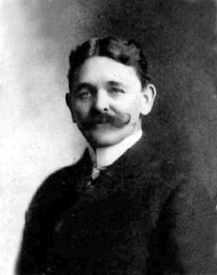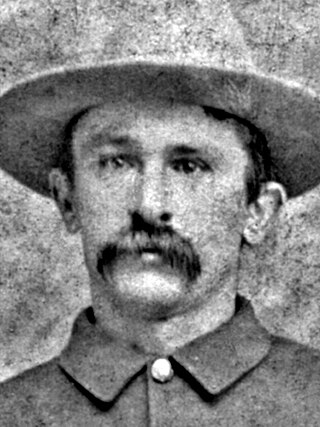This article needs additional citations for verification .(October 2022) |
The Hunnewell gunfight (August 21, 1884) was an Old West gunfight occurring in Hunnewell, Kansas occurring on August 21, 1884. The gunfight involved no known gunmen.
This article needs additional citations for verification .(October 2022) |
The Hunnewell gunfight (August 21, 1884) was an Old West gunfight occurring in Hunnewell, Kansas occurring on August 21, 1884. The gunfight involved no known gunmen.
Before the shootout, Hunnewell, Kansas was a town frequented by cowboys working on the local ranches and corrals. At the time, Hunnewell was a prosperous cattle town, serving as a shipping point for Texas cattle. The Leavenworth, Lawrence and Galveston Railroad provided quick access to the Kansas City, Kansas stockyards, and in the towns heyday it had one hotel, two general stores, one barber shop, two dance halls, and eight saloons, including Hanley’s Saloon (where the gunfight took place). With little more than railroad workers and cowboys, violence was common. There were no lawmen to speak of during the 1880s in or around that area, and typically cattle rustling and other crimes were dealt with by the ranchers themselves.
On August 21, 1884, [1] cowboys Oscar Halsell and Clem Barfoot entered Hanley's Saloon and quickly became drunk, causing a disturbance in the salloon. Soon after, two Kansas [2] lawmen entered also, and although only passing through, they attempted to quiet the disturbance. This developed into an argument, which quickly resulted in several people drawing pistols. Who shot first is not known, but is believed that Clem Barfoot actually fired the first round. Several shots followed, resulting in Barfoot being killed and Deputy Sheriff Ed Scotten mortally wounded. [3]
No one was ever prosecuted, and although publicised at the time, the gunfight was soon forgotten. Oscar Halsell would go on to be a prosperous rancher, later employing such notable outlaws as Bill Doolin and George "Bitter Creek" Newcomb. Halsell was also close friends to later U.S. Marshal Evett D. Nix.

The gunfight at the O.K. Corral pitted lawmen against members of a loosely organized group of cattle rustlers and horse thieves called the Cowboys on October 26, 1881. While lasting less than a minute, the gunfight has been the subject of books and films into the 21st century. Taking place in the town of Tombstone in Arizona Territory, the battle has become one archetype of the American Old West. The gunfight was the result of a long-simmering feud between five outlaws and four representatives of the law, including three brothers. The trigger for the event was the local marshal's decision to enforce a city ordinance that prohibited the carrying of weapons into town. To enforce that ordinance, the lawmen would have to disarm the Cowboys.

Hunnewell is a city in Sumner County, Kansas, United States. As of the 2020 census, the population of the city was 44.

Gunfighters, also called gunslingers or in the late 19th and early 20th century gunmen, were individuals in the American Old West who gained a reputation of being dangerous with a gun and participated in shootouts. Today, the term "gunslinger" is more or less used to denote someone who is quick on the draw with a handgun, but this can also refer to those armed with rifles and shotguns. The gunfighter is also one of the most popular characters in the Western genre and has appeared in associated films, television shows, video games, and literature.
Gustav Krempkau was an El Paso County constable in the late 19th century in El Paso, Texas, during the climax of the "Wild West" era. He died in the Four Dead in Five Seconds Gunfight, which was overshadowed by the events of a few months later at the O.K. Corral. Little is known of his early life, but he is believed to have been about 25 years old when he was killed.

The Long Branch Saloon was a well-known saloon in Dodge City, Kansas, from about 1874 to 1885. It had several owners, most notably Chalk Beeson and gunfighter Luke Short. The establishment provided gambling and live entertainment, including Beeson's five-person orchestra. It was the scene of several altercations, shoot-outs, gunfights, and standoffs often associated with cattle towns in the American wild west. Most famous was the 1879 Long Branch Saloon Gunfight, in which Frank Loving killed Levi Richardson.
The Gunfight at Hide Park, or the Newton Massacre, was the name given to an Old West gunfight that occurred on August 19, 1871, in Newton, Kansas, United States. While well publicized at the time, the shootout has received little historical attention despite resulting in a higher body count than the Gunfight at the O.K. Corral and the Four Dead in Five Seconds Gunfight of 1881. Unlike most other well-known gunfights of the Old West, it involved no notable or well-known gunfighters, nor did it propel any of its participants into any degree of fame. The story has transformed into legend due to reports that one of the participants, James Riley, walked away from the scene and was never seen again.
Kinch 'James' Riley was a young man from Kansas who, on August 19, 1871 was the deciding factor in a little-known but deadly gunfight, which became known as the Gunfight at Hide Park, that took place in Newton, Kansas. The gunfight, despite being lesser known than either the Gunfight at the O.K. Corral or the Four Dead in Five Seconds Gunfight, resulted in more dead.
Mike McCluskie (?-1871) was a little-known gambler and occasional lawman from Ohio, who was the instigator of the Gunfight at Hide Park, which took place on August 19, 1871, in Newton, Kansas.

Evett Dumas Nix, often known as E. D. Nix, was a United States Marshal in the late 19th century handling the jurisdiction that included the wild Oklahoma Territory, later to be the state of Oklahoma. He was first appointed in 1893, in the closing years of the Old West, during the last years of the "Hanging Judge" Parker tenure.

The Long Branch Saloon gunfight, on April 5, 1879, was an altercation that took place between Frank Loving and Levi Richardson at the Long Branch Saloon in Dodge City, Kansas. Both men were gamblers who frequented the saloon.
Billy Thompson, sometimes known as Texas Billy Thompson was an Old West gunman and gambler, and the younger brother of the famous gunman and lawman Ben Thompson. The younger Thompson brother never achieved the fame that his brother achieved, and in his own lifetime was mainly referred to as the unpredictable and troubled younger brother of Ben Thompson. Factually, however, while a dangerous man, he also was a formidable opponent in a gunfight.
The Horrell brothers, sometimes referred to as the lawless Horrell boys, were five brothers from the Horrell family of Lampasas County, Texas, who were outlaws of the Old West, and who committed numerous murders over a five-year period before four of the brothers were killed in different incidents. The brothers are probably best known for the Horrell-Higgins feud, although it resulted in relatively few deaths compared to other feuds. However, starting in 1873, the brothers went on an ethnically motivated killing spree during which they killed a Hispanic lawman and a white lawman in New Mexico, killed 11 other Hispanic men, and wounded one Hispanic woman. The brothers had previously killed five lawmen in Texas.
Dan Tucker, better known as "Dangerous Dan" Tucker,, is a little-known Canadian-American lawman and gunfighter of the Old West.

The Cochise County Cowboys is the modern name for a loosely associated group of outlaws living in Pima and Cochise County, Arizona in the late 19th century. The term "cowboy", as opposed to "cowhand," had only begun to come into wider usage during the 1870s. In that place and time, "cowboy" was synonymous with "cattle rustler". Such thieves frequently rode across the border into Mexico and stole cattle from Mexican ranches that they then drove back across the border to sell in the United States. Some modern writers consider them to be an early form of organized crime in America.

The Big Fight at the Jenkins Saloon, also known as the Tascosa Gunfight or simply the Big Fight, was an incident that took place in the Old West town of Tascosa, Texas, on March 21, 1886, between members of two Texas Panhandle ranch factions: the LS Ranch's Home Rangers and a group of small ranchers and cattle rustlers known as "The System".

The Canyon Diablo shootout was a gunfight between American lawmen and a pair of bandits that occurred on April 8, 1905, in the present-day ghost town of Canyon Diablo, Arizona. On the night before, two men named William Evans and John Shaw robbed a saloon in Winslow and made off with at least $200 in coins. Two lawmen pursued the bandits and on the following day they encountered each other in Canyon Diablo. A three-second shootout ensued, which was described at the time as "one huge explosion" that resulted in the death of Shaw and the wounding and capture of Evans.

Dora Hand, her stage name was Fannie Keenan,, was an American dance hall singer and actress in Dodge City, Kansas, who was mistakenly shot to death from ambush by a young unwanted suitor who was acquitted of criminal charges in the case. Hand was also linked romantically with James H. "Dog" Kelley, the mayor of Dodge City from 1867 to 1871.
A cattle town was a frontier settlement in the Midwestern United States that catered to the cattle industry. The economies of these communities were heavily dependent on the seasonal cattle drives from Texas, which brought the cowboys and the cattle that these towns relied upon. Cattle towns were found at the junctions of railroads and livestock trails. These towns were the destination of the cattle drives, the place where the cattle would be bought and shipped off to urban meatpackers, midwestern cattle feeders, or to ranchers on the central or northern plains. Cattle towns were made famous by popular accounts of rowdy cowboys and outlaws who were kept under control by local lawmen, but those depictions were mostly exaggeration and myth.

Hugh Anderson was a cowboy and gunfighter who participated in the infamous Gunfight at Hide